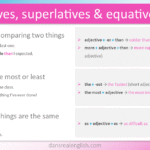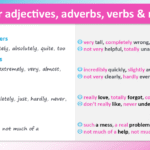Relative clauses are a useful area of English grammar to learn.
They can make nouns sound more interesting, and they can also help us build longer sentences in English.
(And yes, that last sentence is an example of a relative clause with “which”).
Relative clauses start with words like who, which, that, and where. Some give us essential information, while others provide extra details.
This guide will help you learn more about using defining and non-defining relative clauses in English.
Contents
Understanding Relative Clauses
What is a relative clause?
A relative clause adds more information about a noun. It usually comes right after the noun it describes.
Examples:
- The woman who lives next door is very friendly.
- My house, which has a big garden, is near the city centre.
Defining vs. non-defining clauses
Quick summary:
- Use defining clauses when the information is necessary.
- Use non-defining clauses for extra details (use commas).
Defining relative clauses
Defining clause: The teacher who teaches maths is very kind.
These give essential information about the noun they refer to. Without this information, we don’t know who or what we are talking about.
No commas. You can use “that” or leave out the pronoun in some cases.
Examples:
- The teacher who teaches maths is very kind.
- This is the book that I borrowed.
- The shop we visited yesterday is closed now.
Common relative pronouns:
- who (for people)
- which (for things)
- that (for people or things)
- where (for places)
Non-defining relative clauses
Non-defining clause: My brother, who lives in Berlin, is coming tomorrow.
These give extra, non-essential information. They go between commas.
Use commas. Do not use “that.” Do not leave out the pronoun.
Examples:
- My brother, who lives in Berlin, is coming tomorrow.
- Our hotel, which was very clean, had a great view.
- This cafe, where we met last year, is still open.
Key differences
Mini reference chart: Summary of relative clause rules
| Use this pronoun | For… | Example |
|---|---|---|
| who | people | The lady who lives here.. |
| which | things | The books which were on the table.. |
| that | people/things (only in defining clauses) | The girl that said “Hi!”.. |
| where | places | The flat where he lived.. |
Leaving out the relative pronoun
Question: Where are the relative pronouns in these sentences? Are they correct?
- The person I met was friendly.
- The teacher who lives nearby is new.
- The book I borrowed was excellent.
Answer: The sentences have no who / where / which / that because the style is less formal, so you can choose.
However, we can leave out the relative pronoun (who, which, that) in defining relative clauses ONLY when the pronoun refers to the object of the clause, NOT the subject. So:
You can leave out the pronoun when you’re talking about the OBJECT:
- The book that I read was interesting. → OR: The book I read was interesting.
- The person who I met was very kind. → OR: The person I met was very kind.
You must include the pronoun when you’re talking about the SUBJECT:
- The girl who called you is my sister. → “who” refers to the subject, so we must keep it.
- The dog that barked all night is mine. → “that” is the subject, so we must keep it.
Reduced Relative Clauses
A reduced relative clause is another way to make defining relative clauses shorter.
Example:
- Reduced: All of the students living in this building have free meals.
- Full: All of the students who live / who are living in this building…
How to reduce different types of clauses
We can reduce relative clauses in two main ways, depending on whether the original verb is active or passive:
Reduced relative clauses with -ing
We can use reduced relative clauses when the subject of the clause is doing something (an active verb).
Example:
- Full: The man who is talking to John is our teacher.
- Reduced: The man talking to John is our teacher.
Reduced relative clauses with passive voice
This is used when the subject of the clause is receiving the action (a passive verb).
Example:
- Full: Books that were written by this author are popular.
- Reduced: Books written by this author are popular.
Examples of reduced clauses:
- The man talking to John is our teacher. (Full: The man who is talking to John…)
- Books written by this author are popular. (Full: Books that were written by this author…)
- Students living in this building have free meals. (Full: Students who live in this building…)
Relative clause exercises:
Exercise 1 – Complete the sentence
Write a defining or non-defining relative clause.
- The girl ________________________ is my cousin. (She has red hair)
- My phone, ________________________, is very old. (I bought it in 2018)
- That’s the shop _________________________. (We bought our jackets there)
- Mr Brown, _________________________, is our new teacher. (He lives next door)
- The room _________________________ is very cold. (It faces the north)
Exercise 2 – Can you omit the pronoun?
Decide if the relative pronoun can be left out. Write “YES” if it can be omitted, or “NO” if it cannot.
- The man who lives next door is a doctor.
- The book that I read was very long.
- The girl who won the prize is my friend.
- The shoes that I bought are very comfortable.
- The cat that sleeps on the sofa is old.
Exercise 3 – Choose the correct option
- This is the car ___ I told you about. a) who b) where c) that
- My sister, ___ lives in Canada, is a nurse. a) that b) who c) which
- That’s the building ___ I used to work. a) which b) where c) who
Answer key
Exercise 1
- who has red hair
- which I bought in 2018
- where we bought our jackets
- who lives next door
- which faces the north
Exercise 2
- NO
- YES
- NO
- YES
- NO
Exercise 3
- c) that
- b) who
- b) where
Get more FREE English grammar lessons here!







